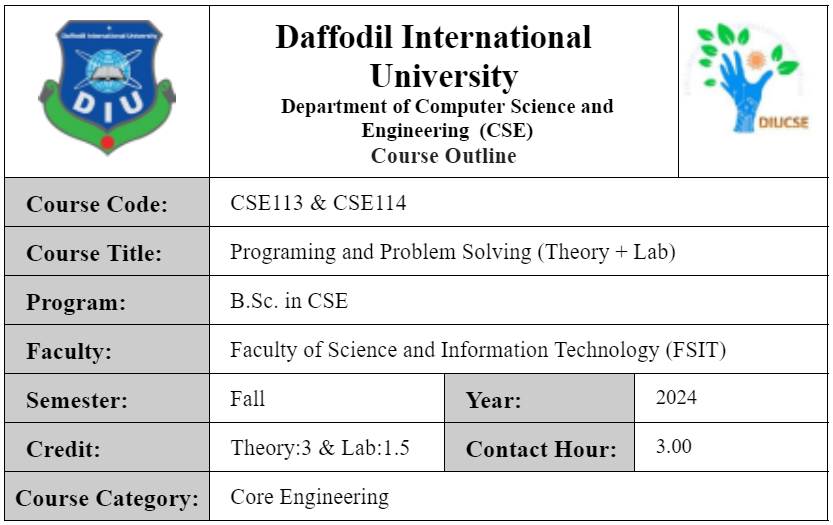Section outline
-

Programming and Problem Solving and Lab
Quick Navigation: || Attendance || Demo Quiz || Quiz 1 || Quiz 2 || Quiz 3 || Presentation || Mid || Final ||
|| Week 1 || Week 2 || Week 3 || Week 4 || Week 5 || Week 6 || Week 7 || Week 8 || Week9 || Week10 || Week11 || Week12 ||
Welcome NoteDear students,
Welcome to the CSE114 Programming and Problem Solving course. I am your instructor, Mehadi Hasan. Whether we meet in person or virtually, the course’s high standards and materials remain consistent. Dedication, self-motivation, and discipline are essential for success in both scenarios. For physical classes, we’ll have face-to-face interactions, while the virtual environment provides flexibility. Regardless of the format, active participation and engagement are crucial. Throughout this journey, I am here to support you. Let's make this semester outstanding as we delve into the world of programming and problem solving together.
InstructorAmatul Bushra Akhi
Assistant Professor
Department of CSE
Daffodil International UniversityEmail: akhi.cse@diu.bd
Office: 733 (KT)
Course RationaleIn the realm of computer science, the central focus is on using computers to tackle problems. These problems may arise from real-world scenarios or even abstract concepts. At the core of computer science lies computer programming—the practical aspect of software development, application building, and software engineering. It involves translating theoretical ideas into functional, tangible solutions.
Course ObjectiveThe main objective of this course is to introduce students to fundamental programming concepts and problem-solving techniques. Through an in-depth study of the C programming language, students will gain essential skills. The course emphasizes practical problem-solving abilities by guiding students through the process of designing, implementing, and executing C programs.
Course Outcomes (CO’s)CLO1Able to solve computing problems, Expression Evaluation using programming concepts and learn the basic concept of ACM Problem solving techniques.CLO2Able to apply fundamental programming elements including: variable, use of data types and data structures, decision structures, loop structures, pointer, string, console, file IO, and functionsCLO3Able to specify the problem requirements, analyze the problem, design the algorithm to solve the problem and implement with the help of programming language.CLO4Able to apply the knowledge of programming and problem solving in real life problems.Text/REFERENCE BooksMark Distribution (Theory)Attendance07Assignment05Class Test15Presentation08Mid-term Exam25Final Exam40Total100Mark Distribution (Lab)Attendance10Lab Performance25Lab Project25Lab Final40Total100Tentative Semester SCHEDULEClass Start 18th JanuaryQuiz 1 1st week of FebruaryQuiz 2 4th week of FebruaryMid 2nd-16th MarchQuiz 3 4th week of AprilFinal 28th May-10th June
